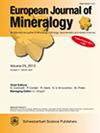德国易北河碎屑铂族矿物和金颗粒的矿物学和矿物化学
IF 1.7
3区 地球科学
Q2 MINERALOGY
引用次数: 0
摘要
摘要在易北河的重矿物精矿中,可以观察到金和铂族矿物(PGM)。两个分数(> 63和 80 原子 %), (2) 铁氧体Pt(20 原子 % 至50 原子 %Fe)、(3)异铁铂(2.64至3.04 总PGE的apfu,铂族元素),(4)镍的四铁铂族 + Cu + Fe ≈ 50 原子 %, 和(5)γ(Pt,Fe)与总PGE > 3.04 apfu。Os–Ir–Ru–(Pt)合金显示出较大的成分变化。富铱的Os–Ir–Ru合金中通常观察到铂和铁的富集。由于银的选择性提取,金颗粒通常表现出富银核和贫银边缘的成分分区。同样,分析了金颗粒的富汞边缘。这些被解释为由于相关朱砂颗粒中Hg的动员而导致的原位融合的结果。金颗粒的大小和形状通常说明运输距离较短。类似地,几乎自形的sperylite和Pt–Fe合金表明源区靠近采样点。然而,圆形的Os–Ir–Ru–(Pt)合金可能在河流中经历了更长的运输。Lusatia区块的辉长岩岩脉含有亚铁矿石和金颗粒,这可能是精矿中发现这些颗粒的来源。Os–Ir–Ru–(Pt)合金的成分与捷克共和国先前对Vestřevplacer的研究相似。这两个位置都位于易北河流域内,因此可能是精矿中PGM和金颗粒的来源。本文章由计算机程序翻译,如有差异,请以英文原文为准。
Mineralogy and mineral chemistry of detrital platinum-group minerals and gold particles from the Elbe, Germany
Abstract. In heavy mineral concentrates of the Elbe, gold and
platinum-group minerals (PGMs) are observed. Two fractions (> 63
and < 63 µm) of the concentrate are analyzed by
reflected-light microscopy, scanning electron microscopy with automated
mineralogy software and electron microprobe analysis (EPMA). Other heavy
minerals are cassiterite, ferberite, monazite, uraninite,
columbite–tantalite, magnetite, zircon and cinnabar. Scanning electron
microscopy determined the modal abundance of PGMs, gold and the other heavy
minerals. The PGMs are mainly Os–Ir–Ru–(Pt) alloys, Pt–Fe alloys, sperrylite
and rustenburgite. Compositional variation of PGMs and gold was analyzed by
EPMA. This showed that Pt–Fe alloys are (1) native platinum (> 80 atom %), (2) ferroan Pt (20 atom % to 50 atom % Fe), (3) isoferroplatinum (2.64 to 3.04 apfu of sum PGE, platinum-group
element), (4) tetraferroplatinum group with Ni + Cu + Fe ≈ 50 atom %, and (5)
γ(Pt,Fe) with sum PGE > 3.04 apfu. The Os–Ir–Ru–(Pt)
alloys show large compositional variations. Platinum and Fe enrichment is
typically observed for Ir-rich Os–Ir–Ru alloys. Gold particles often show
compositional zoning of Ag-rich cores and Ag-poor rims due to selective
leaching of Ag. Similarly, Hg-rich rims of gold particles are analyzed.
These are interpreted as the results of in situ amalgamation due to mobilization of
Hg from the associated cinnabar particles. The size and shape of the gold
particles generally argue for short transportation distances. Similarly,
almost euhedral sperrylite and Pt–Fe alloys suggest a source region close to
the sampling site. However, roundish Os–Ir–Ru–(Pt) alloys presumably have
experienced longer transportation in the river. Gabbroic dikes of the
Lusatia block contain sperrylite and gold particles, which can be the source
for these particles found in the concentrate. The composition of the
Os–Ir–Ru–(Pt) alloys is similar to previous studies on the Vestřev
placer in Czech Republic. Both locations are within the drainage area of the
Elbe and can therefore be the source of the PGM and gold particles in
the concentrate.
求助全文
通过发布文献求助,成功后即可免费获取论文全文。
去求助
来源期刊
CiteScore
2.80
自引率
9.50%
发文量
40
审稿时长
6-12 weeks
期刊介绍:
EJM was founded to reach a large audience on an international scale and also for achieving closer cooperation of European countries in the publication of scientific results. The founding societies have set themselves the task of publishing a journal of the highest standard open to all scientists performing mineralogical research in the widest sense of the term, all over the world. Contributions will therefore be published primarily in English.
EJM publishes original papers, review articles and letters dealing with the mineralogical sciences s.l., primarily mineralogy, petrology, geochemistry, crystallography and ore deposits, but also biomineralogy, environmental, applied and technical mineralogy. Nevertheless, papers in any related field, including cultural heritage, will be considered.

 求助内容:
求助内容: 应助结果提醒方式:
应助结果提醒方式:


